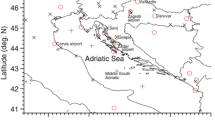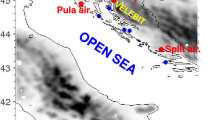Abstract.
A study of Terra Nova Bay (TNB) winter polynya, based on the combined use of satellite observations and limited area model simulations, is presented. First, data from passive microwave observations are used to investigate the polynya area daily variability. Second, the Eta model is run to simulate the low-level wind over a defined TNB polynya, located in according to the satellite images, during the period 15-17 September 2003. A preliminary set up of initial and boundary conditions is used. The Eta model is initialized with the European Centre for Medium-Range Weather Forecasts (ECMWF) analyses, with the National Centers for Environmental Prediction (NCEP) of the U.S. National Weather Service data and with information from satellite images providing a realistic extension of the polynya under study. The Eta model simulates a katabatic wind system which develops qualitatively in agreement with the polynya extent, as shown in the satellite images during the same period. The results demonstrate the strong effect of the polynya when included in the initialization of model integrations: the low-level wind is intensified by the presence of the warm area corresponding to the polynya, it is spatially variable and significantly different from one simulated along the coast of the Nansen Ice Sheet. The results of numerical simulations with different surface temperatures in the polynya area are shown as well, thus an assessment of the range of variability of the wind intensity in relation to the polynya surface temperature is provided.
Similar content being viewed by others
References
D.H. Bromwich, D.D. Kurtz, J. Geophys. Res. 89, 3561 (1984)
S.D. Smith, R.D. Muench, C.H. Pease, J. Geophys. Res. 95, 9461 (1990)
M. Van Woert, J. Geophys. Res. 104, 7753 (1999)
F. Parmiggiani, Int. J. Remote Sensing 27, 2459 (2006)
E.K. Fiedler et al., J. Geophys. Res. 115, C10051 (2010) DOI:10.1029/2009JC005797
S. Morelli, Meteor. Atmos. Phys. 114, 67 (2011) DOI:10.1007/s00703-011-0157.5
S. Morelli, F. Parmiggiani, Eta Model Simulations and AMSR Images to Study an Event of Polynya at Terra Nova Bay, Antarctica, in Climate Change. Inferences from Paleoclimate and Regional Aspects, edited by A. Berger, F. Mesinger, D. Sijacki (Springer Verlag, Wien, 2012) pp. 215--225 DOI:10.1007/978-3-7091-0973-1_16
H. Gallée, J. Geophys. Res. 102, 13835 (1997)
R.A. Dare, B.W. Atkinson, J. Geophys. Res. 104, 16691 (1999) DOI:10.1029/1999JD900137
R.A. Dare, B.W. Atkinson, Boundary-Layer Meteorol. 94, 65 (2000)
G. Heinemann, Forcing and feedback mechanisms between the katabatic wind and sea ice in the coastal areas of polar ice sheets, in The Global Atmosphere and Ocean System, Vol. 9, n. 4 (Taylor & Francis Ltd., 2003) p. 169
D.D. Kurtz, D.H. Bromwich, A recurring atmospherically forced polynya in Terra Nova Bay, in Oceanology of the Antarctic Continental Shelf, edited by S.S. Jacobs, in Antarctic. Res. Ser., Vol. 43 (AGU, Washington, D.C., 1985) pp. 177--201 DOI:10.1029/AR043p0177
D. Cesini, S. Morelli, F. Parmiggiani, Nat. Hazards Earth Syst. Sci. 4, 323 (2004)
M. Stortini, S. Morelli, S. Marchesi, Nuovo Cimento C 23, 147 (2000)
F. Parmiggiani, A first experiment of real near time (NRT) processing of ENVISAT/ASAR images to assist ship routing in Antarctica, ENVISAT/ERS Symposium, Salzburg, 6--10 Sep. 2004 (Abstract n. 12)
A. Hauser, M. Lythe, G. Wendler, Atmosphere Ocean 40, 281 (2002)
L. Kaleschke et al., Can. J. Remote Sensing 27, 526 (2001)
T. Markus, D.J. Cavalieri, IEEE Trans. Geosci. Remote Sensing 38, 1387 (2000)
G. Spreen, L. Kaleschke, G. Heygster, J. Geophys. Res. 113, C02S03 (2008) DOI:10.1029/2005JC003384
M.B. Ek et al., J. Geophys. Res. 108, 8851 (2003) DOI:10.1029/2002/D003296
F. Mesinger et al., Mon. Wea. Rev. 116, 1493 (1988)
F. Mesinger, T.L. Black, Meteor. Atmos. Phys. 50, 47 (1992)
M. Georgelin et al., Mon. Wea. Rev. 122, 1509 (1994)
F. Mesinger, R.L. Wobus, M.E. Baldwin, Parameterization of form drag in the Eta Model at the National Centers for Environmental Prediction, in 11th Conference on Numerical Weather Prediction, Norfolk, VA, (American Meteorological Society, 1996) pp. 324-326
C.A. Paulson, J. Appl. Meteor. 9, 857 (1970)
L. Lobocki, J. Appl. Meteor. 32, 126 (1993)
H. Charnok, Quart. J. R. Meteor. Soc. 81, 639 (1955)
S.S. Zilitinkevich, Non-local turbulent transport: Pollution dispersion aspects of coherent structure of convective flows, in Air Pollution III. Air Pollution Theory and Simulation, edited by H. Power, N. Moussiopoulos, C.A. Brebbia, Vol. I (Computational Mechanics Publications, Southampton, Boston, 1995) pp. 53-60
G.L. Mellor, T. Yamada, Rev. Geophys. Space Phys. 20, 851 (1982)
Z.J. Janjic, The Mellor Yamada level 2.5 turbulence closure scheme in the NCEP Eta Model, in Research Activities in Atmospheric and Oceanic Modelling (WMO, Geneva, CAS/WGNE, 1996) pp. 4.14-4.15
Z.J. Janjic, NCEP Office Note No. 437 (2002)
F. Mesinger, IOP Conf. Ser.: Earth Environ. Sci. 13, 012005 (2010) DOI:10.1088/1755-1315/13/1/012005
F. Chen et al., J. Geophys. Res. 101, 7251 (1996)
V. Koren et al., J. Geophys. Res. 104, 19569 (1999) DOI:10.1029/1999JD900232
A.A. Lacis, J.E. Hansen, J. Atmos. Sci. 31, 118 (1974)
S.B. Fels, M.D. Schwarzkopf, J. Atmos. Sci. 32, 1475 (1975)
M.D. Schwarzkopf, S.B. Fels, J. Geophys. Res. 96, 9075 (1991)
A.K. Betts, M.J. Miller, Quart. J. R. Meteor. Soc. 112, 693 (1986)
Z.J. Janjic, Mon. Wea. Rev. 122, 927 (1994)
B.S. Ferrier, Implementation of a new grid-scale cloud and precipitation scheme in the NCEP Eta Model, in 19th Conference on Weather Analysis and Forecasting/15th Conference on Numerical Weather Prediction, San Antonio, TX (American Meteorological Society, 2002)
T. Markus, A. Burns, J. Geophys. Res. 100, 4473 (1995)
H.J. Zwally, NASA Spec. Publ. 459, NASA Goddard Space Flight Center, Greenbelt, MD (1983)
T. Ishikawa et al., J. Oceanograp. 52, 389 (1996)
C.C. Comiso, D.J. Cavalieri, T. Markus, IEEE Trans. Geosci. Remote Sensing 41, 243 (2003)
R. Kwok, J.C. Comiso, S. Martin, R. Drucker, J. Geophys. Res. 112, C12012 (2007) DOI:10.1029/2006JC003967
S. Kern, Geophys. Res. Lett. 36, L14501 (2009) DOI:10.1029/2009GL038062
M. Shokr, K. Asmus, T.A. Agnew, IEEE Trans. Geosci. Remote Sensing 47, 325 (2009)
T. Hollands, W. Dierking, Proceedings of ESA Living Planet Symposium, Edinburgh, UK, 2013, edited by Y.L. Desnos,in press
Adams et al., Polar Res. 30, 7124 (2011) DOI:10.3402/polar.v30i0.7124
D.H. Bromwich, J.F. Carrasco, C.R. Stearns, Mon. Wea. Rev. 120, 1940 (1992)
D.H. Bromwich et al., J. Geophys. Res. 98, 13045 (1993) DOI:10.1029/93JD00562
H. Hebbingaus, H. Schlunzen, S. Dierer, Theor. Appl. Climatol. 88, 1 (2007) DOI:10.1007/s00704-006-0233-9
Author information
Authors and Affiliations
Corresponding author
Rights and permissions
About this article
Cite this article
Morelli, S., Parmiggiani, F. Wind over Terra Nova Bay (Antarctica) during a polynya event: Eta model simulations and satellite microwave observations. Eur. Phys. J. Plus 128, 135 (2013). https://doi.org/10.1140/epjp/i2013-13135-8
Received:
Revised:
Accepted:
Published:
DOI: https://doi.org/10.1140/epjp/i2013-13135-8




